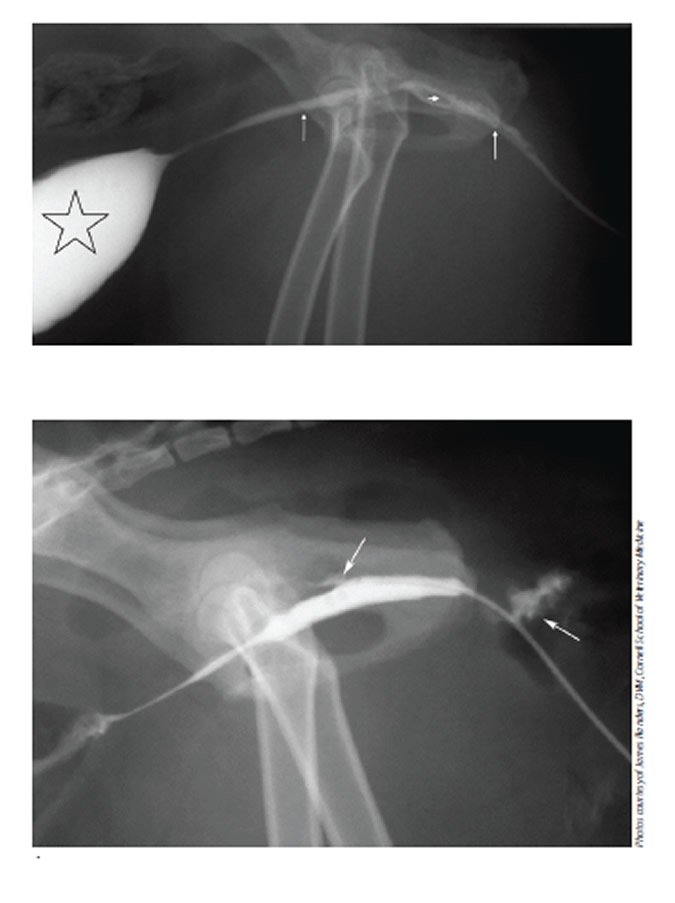In one large study, slightly over half of the cats that suffered from a urethral rupture had been subjected to direct and intense trauma, primarily by being hit by car and suffering from pelvic injuries. Just under half had experienced a partial rupture while being catheterized for a urinary blockage. Male cats are more commonly afflicted because they are more susceptible to urinary blockages, which may require catheterization, and are more likely to be outside, which increases risk of trauma.
“To definitively diagnosis a urethral rupture, your veterinarian may need to do a specialized x-ray study called retrogradeurethography. A radio-opaque dye is injected into the urethra through a catheter while a radiograph is taken. Normally, the dye should pass through the urethra into the urinary bladder. However, if there is a tear in the urethra the dye will be seen leaking into the pelvic canal or the abdomen (see images). If your cat has abdominal trauma and requires surgery, a rupture may be noted during the surgery,” says James Flanders DVM DACVS, Associate Professor of Small Animal Surgery at the Cornell University School of Veterinary Medicine.

Treatment
Luckily, urethral tissues tend to heal rapidly—possibly as fast as five days. If urine can be diverted, so it is not in the healing area and urethral mucosal tissues are mostly intact, then even deep tears can heal in two to three weeks. If the urethra is torn in half, there is a greater risk of strictures developing while healing. This is related to the presence of suture material and scarring as the incision heals.
Cats with partial tears may be treated with just an indwelling urinary catheter, which keeps the urethra from scarring down and allows urine to flow freely out of the body. In many cases, a catheter can be placed from outside to inside via the penis or vulva.
With a full rupture, however, a catheter may need to be placed from inside to outside via the bladder. An indwelling catheter needs to remain in place until the tissues have healed, usually from five to 14 days. The catheter allows urine to flow freely while protecting the tissues and preventing urine from leaking into other tissues around the rupture.
Meanwhile, the ruptured and damaged tissues have a template to heal around, thus reducing the risk of stricture. Your cat will need to wear an Elizabethan collar (a cone-shaped collar that stops the cat from reaching around himself) to prevent him from removing the catheter prematurely.
Depending on where the rupture occurred, a perineal urethrostomy, with removal of the distal urethra and the penis, may be required. These cases often are associated with urinary blockage, and the surgery may be recommended even without a urethral rupture to prevent recurrence of the blockage.
A tube cystostomy may be done as a temporary measure. “In this surgery, your veterinarian inserts a urinary catheter through the abdominal wall and into the urinary bladder to divert urine safely out of your cat’s body while the urethral rupture heals,” says Dr. Flanders.
This is more likely to be required with a full rupture and a surgical repair. In cats with extensive pelvic trauma, a cystostomy tube may allow for urine passage while more pressing injuries are treated.
Prognosis
The prognosis for cats recovering from urethral rupture is often affected more by the additional injuries, such as pelvic fractures, than the urethral rupture itself. Urine leakage into tissues can cause cellulitis that requires treatment as well. Iatrogenic injuries (caused by catheterization procedures for urinary blockage) tend to be partial ruptures and generally have a better prognosis than traumatic ruptures.



